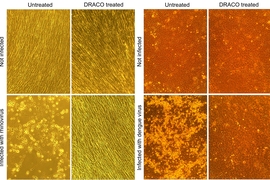Most bacterial infections can be treated with antibiotics such as penicillin, discovered decades ago. However, such drugs are useless against viral infections, including influenza, the common cold, and deadly hemorrhagic fevers such as Ebola.
Now, in a development that could transform how viral infections are treated, a team of researchers at MIT’s Lincoln Laboratory has designed a drug that can identify cells that have been infected by any type of virus, then kill those cells to terminate the infection.

The microscope images above show that DRACO successfully treats viral infections. In the left set of four photos, rhinovirus (the common cold virus) kills untreated human cells (lower left), whereas DRACO has no toxicity in uninfected cells (upper right) and cures an infected cell population (lower right). Similarly, in the right set of four photos, dengue hemorrhagic fever virus kills untreated monkey cells (lower left), whereas DRACO has no toxicity in uninfected cells (upper right) and cures an infected cell population (lower right). | Enlarge image
In a paper published July 27 in the journal PLoS One, the researchers tested their drug against 15 viruses, and found it was effective against all of them — including rhinoviruses that cause the common cold, H1N1 influenza, a stomach virus, a polio virus, dengue fever and several other types of hemorrhagic fever.
The drug works by targeting a type of RNA produced only in cells that have been infected by viruses. “In theory, it should work against all viruses,” says Todd Rider, a senior staff scientist in Lincoln Laboratory’s Chemical, Biological, and Nanoscale Technologies Group who invented the new technology.
Because the technology is so broad-spectrum, it could potentially also be used to combat outbreaks of new viruses, such as the 2003 SARS (severe acute respiratory syndrome) outbreak, Rider says.
Other members of the research team are Lincoln Lab staff members Scott Wick, Christina Zook, Tara Boettcher, Jennifer Pancoast and Benjamin Zusman.
Few antivirals available
Rider had the idea to try developing a broad-spectrum antiviral therapy about 11 years ago, after inventing CANARY (Cellular Analysis and Notification of Antigen Risks and Yields), a biosensor that can rapidly identify pathogens. “If you detect a pathogenic bacterium in the environment, there is probably an antibiotic that could be used to treat someone exposed to that, but I realized there are very few treatments out there for viruses,” he says.
There are a handful of drugs that combat specific viruses, such as the protease inhibitors used to control HIV infection, but these are relatively few in number and susceptible to viral resistance.
Rider drew inspiration for his therapeutic agents, dubbed DRACOs (Double-stranded RNA Activated Caspase Oligomerizers), from living cells’ own defense systems.
When viruses infect a cell, they take over its cellular machinery for their own purpose — that is, creating more copies of the virus. During this process, the viruses create long strings of double-stranded RNA (dsRNA), which is not found in human or other animal cells.
As part of their natural defenses against viral infection, human cells have proteins that latch onto dsRNA, setting off a cascade of reactions that prevents the virus from replicating itself. However, many viruses can outsmart that system by blocking one of the steps further down the cascade.
Rider had the idea to combine a dsRNA-binding protein with another protein that induces cells to undergo apoptosis (programmed cell suicide) — launched, for example, when a cell determines it is en route to becoming cancerous. Therefore, when one end of the DRACO binds to dsRNA, it signals the other end of the DRACO to initiate cell suicide.
Combining those two elements is a “great idea” and a very novel approach, says Karla Kirkegaard, professor of microbiology and immunology at Stanford University. “Viruses are pretty good at developing resistance to things we try against them, but in this case, it’s hard to think of a simple pathway to drug resistance,” she says.
Each DRACO also includes a “delivery tag,” taken from naturally occurring proteins, that allows it to cross cell membranes and enter any human or animal cell. However, if no dsRNA is present, DRACO leaves the cell unharmed.
Most of the tests reported in this study were done in human and animal cells cultured in the lab, but the researchers also tested DRACO in mice infected with the H1N1 influenza virus. When mice were treated with DRACO, they were completely cured of the infection. The tests also showed that DRACO itself is not toxic to mice.
The researchers are now testing DRACO against more viruses in mice and beginning to get promising results. Rider says he hopes to license the technology for trials in larger animals and for eventual human clinical trials.
This work is funded by a grant from the National Institute of Allergy and Infectious Diseases and the New England Regional Center of Excellence for Biodefense and Emerging Infectious Diseases, with previous funding from the Defense Advanced Research Projects Agency, Defense Threat Reduction Agency, and Director of Defense Research & Engineering (now the Assistant Secretary of Defense for Research and Engineering).








